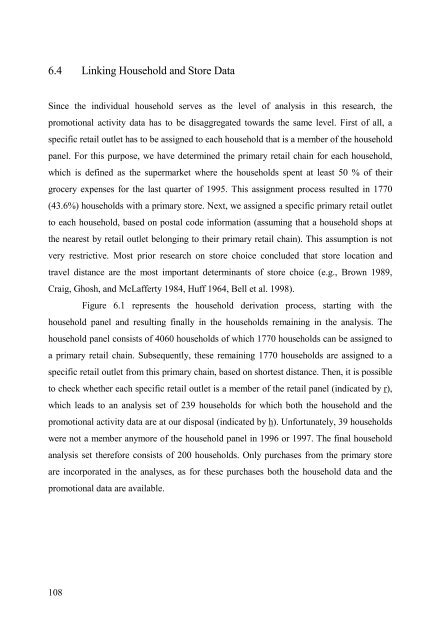Analysis of Sales Promotion Effects on Household Purchase Behavior
Analysis of Sales Promotion Effects on Household Purchase Behavior
Analysis of Sales Promotion Effects on Household Purchase Behavior
Create successful ePaper yourself
Turn your PDF publications into a flip-book with our unique Google optimized e-Paper software.
6.4 Linking <strong>Household</strong> and Store Data<br />
Since the individual household serves as the level <str<strong>on</strong>g>of</str<strong>on</strong>g> analysis in this research, the<br />
promoti<strong>on</strong>al activity data has to be disaggregated towards the same level. First <str<strong>on</strong>g>of</str<strong>on</strong>g> all, a<br />
specific retail outlet has to be assigned to each household that is a member <str<strong>on</strong>g>of</str<strong>on</strong>g> the household<br />
panel. For this purpose, we have determined the primary retail chain for each household,<br />
which is defined as the supermarket where the households spent at least 50 % <str<strong>on</strong>g>of</str<strong>on</strong>g> their<br />
grocery expenses for the last quarter <str<strong>on</strong>g>of</str<strong>on</strong>g> 1995. This assignment process resulted in 1770<br />
(43.6%) households with a primary store. Next, we assigned a specific primary retail outlet<br />
to each household, based <strong>on</strong> postal code informati<strong>on</strong> (assuming that a household shops at<br />
the nearest by retail outlet bel<strong>on</strong>ging to their primary retail chain). This assumpti<strong>on</strong> is not<br />
very restrictive. Most prior research <strong>on</strong> store choice c<strong>on</strong>cluded that store locati<strong>on</strong> and<br />
travel distance are the most important determinants <str<strong>on</strong>g>of</str<strong>on</strong>g> store choice (e.g., Brown 1989,<br />
Craig, Ghosh, and McLafferty 1984, Huff 1964, Bell et al. 1998).<br />
Figure 6.1 represents the household derivati<strong>on</strong> process, starting with the<br />
household panel and resulting finally in the households remaining in the analysis. The<br />
household panel c<strong>on</strong>sists <str<strong>on</strong>g>of</str<strong>on</strong>g> 4060 households <str<strong>on</strong>g>of</str<strong>on</strong>g> which 1770 households can be assigned to<br />
a primary retail chain. Subsequently, these remaining 1770 households are assigned to a<br />
specific retail outlet from this primary chain, based <strong>on</strong> shortest distance. Then, it is possible<br />
to check whether each specific retail outlet is a member <str<strong>on</strong>g>of</str<strong>on</strong>g> the retail panel (indicated by r),<br />
which leads to an analysis set <str<strong>on</strong>g>of</str<strong>on</strong>g> 239 households for which both the household and the<br />
promoti<strong>on</strong>al activity data are at our disposal (indicated by h). Unfortunately, 39 households<br />
were not a member anymore <str<strong>on</strong>g>of</str<strong>on</strong>g> the household panel in 1996 or 1997. The final household<br />
analysis set therefore c<strong>on</strong>sists <str<strong>on</strong>g>of</str<strong>on</strong>g> 200 households. Only purchases from the primary store<br />
are incorporated in the analyses, as for these purchases both the household data and the<br />
promoti<strong>on</strong>al data are available.<br />
108

















